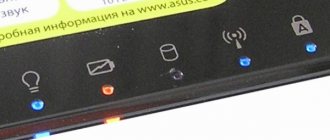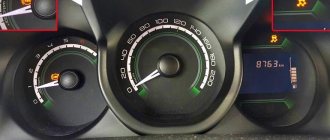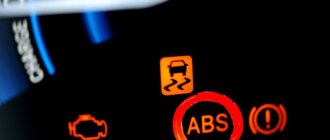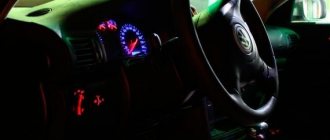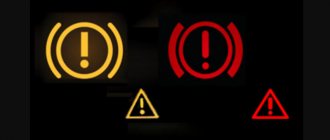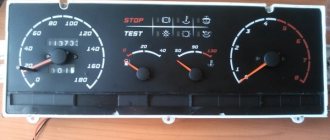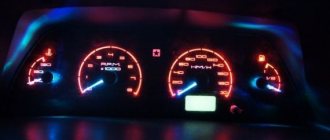How does a generator work?
Before you understand why the battery charging light comes on, you need to understand the principle of operation of the generator.
Any car has two power sources. This is a generator and battery. They are connected in parallel. Therefore, when the engine is running, the generator supplies voltage to the battery and charges it. Moreover, there is one peculiarity. Regardless of the speed, the voltage at the generator output is always the same. To stabilize it, a relay regulator is installed. Older cars used electromechanical-type designs. Modern ones use exclusively semiconductor ones. The lamp, which is installed in the dashboard, is included in the power circuit of the voltage regulator. It essentially serves as a fuse. To understand the essence, it is necessary to thoroughly study the principle of operation of the voltage regulator relay.
Reasons why the battery charging light is on
In fact, there are many reasons why the battery light comes on and does not go out. These include:
- Loosening of the belt tension on the generator, its wear or damage; fuse blown or deterioration of contact quality in the connectors of the mounting block;
- breakdown of the relay regulator, diode bridge, additional diodes;
- the appearance of a break in the generator excitation circuit;
- decreased quality of contact at the battery terminals or generator output;
- generator brush wear;
- lack of high-quality contact of the ground wire.
What to do if the battery charging light is on?
First of all, get out of the car and, with the engine running, measure the voltage at the battery terminals (do not remove the clamps under any circumstances).
If charging is in progress, the voltage should be at 13.6-14.2 Volts. In the absence of charge, the voltage level will be much lower - about 12 Volts.
To fix the problem, prepare the following tools:
- twelve volt indicator light,
- two screwdrivers (flat and Phillips),
- multimeter,
- pliers,
- knife,
- Use sandpaper to clean contacts.
So let's get started:
The readings of the on-board voltmeter indicate the presence of a charge, the charge signal lamp on the dashboard does not light up, there are about 12 volts at the battery terminals, and the battery itself is almost discharged.
In such a situation, clean the wire connections on the power source itself. If these measures are useless, measure the voltage level at terminal “30” of the generator itself.
Place one multimeter probe on this terminal, and the other on ground. If the voltage here is much higher than at the battery, then strip the thirtieth terminal. If necessary, replace the wire from the generator to the battery.
The voltmeter on the dashboard and the lamp show the presence of a charge, but the battery is discharged.
The voltage on the battery is normal (about 14 Volts). Turning on a load (for example, headlights) causes the charge arrow to shift to the extreme left position.
The main reason is weak belt tension on the generator pulley (tighten the belt, and if it is damaged, replace it).
This problem can also be caused by a breakdown of one of the diodes, as well as a break in the stator phase winding. Turn off the ignition and check the diodes with a multimeter. In case of breakdown, replace them.
Check the generator brushes. To do this, take them out and measure the length. If it is less than five millimeters, then it is better to replace the brushes.
When you turn the key in the ignition, the charge warning lamp does not light up, the charge sensor does not work, and there is no charge on the battery. The reason is a blown fuse.
Its designation is F10, rating is 10 Amperes. If installing a new fuse does not produce results, then the reason must be sought in the ignition relay or the lock itself.
After turning on the ignition, there is no charge, all devices work, the warning light does not light up.
The check is simple - remove the wiring from terminal “sixty-one” of the generator and connect it directly to the “minus” (car body). If the light comes on, then the cause of the problem is the generator field winding.
The second option is bad contact in the connector. If after cleaning there is no result, then there is a risk of the lamp itself burning out.
When you turn the key in the ignition, the charge lamp lights up, and after starting it continues to light up. In this case, there is no charging or appears periodically. The reason is insufficient contact of the wire at the connector with the dashboard (it may oxidize).
Finally, check the relay regulator. To do this, apply voltage from the battery to its contacts. If there is 12 volts on the brushes, then the relay is working properly. If not, the device must be replaced.
If you have problems charging the battery (the warning light does not go out or does not light up at all), then check all versions.
But, as a rule, the problem is always on the surface, and the cause is poor contact, a burnt out light bulb or a faulty relay regulator. Good luck on the roads and of course no breakdowns.
Didn't find the information you are looking for? on our forum.
We recommend reading:
VAZ 2106 gearbox oil recommended by the manufacturer
How to adjust the steering wheel on a VAZ 2114
Installing seat belts on a VAZ 2106
Tightening torque for cylinder head vaz 2107 carburetor
How to connect fog lights to a VAZ 2107, installation features, which ones are better to choose, connection diagram
Connection diagram for tow bar for VAZ 2104
VAZ 2110: how the heater on a car works, possible causes of failure
ZDT for VAZ 2114 installation
How to determine the cause
Diagnostics of the circuit in the generator-battery section is usually carried out by exclusion.
You should prepare the following set of tools in advance:
- multimeter;
- load car light bulb;
- screwdrivers with flat and Phillips tips;
- pliers;
- fine-grained sandpaper.
We advise you to start by inspecting the condition of the battery: whether the terminals are oxidized, whether the battery cover is dirty, whether there are swellings or cracks on the body. The battery voltage is checked with a multimeter with the engine not running.
It is strictly not recommended to remove the battery terminal while the engine is running: a sudden surge in voltage can cause failure of the car's electronic components.
The device readings should be in the range of 11.9–12.7 V. If there are traces of oxidation on the battery terminals, they can be removed with sandpaper. It is recommended to treat the terminals with an anti-corrosion compound after this operation.
If there are no complaints about the battery, the next step is a visual inspection of the wiring in the area from the battery to the generator. If there is no visible damage, it is necessary to test the wires for internal breaks.
The functionality of the generator itself is checked at idle engine speed using the following algorithm:
- measurements carried out using a multimeter are carried out with consumers turned off;
- first of all, turn on the low beam of the headlights along with the air conditioner and measure the voltage at the output terminals of the generator, it should be at least 13.5 V;
- without this load, the generator should output 14.0–14.7 V;
- if there is extraneous noise, we can conclude that the bearings are worn;
- the serviceability of the relay regulator is also checked by a tester; a voltage of at least 14.5 V must be output at its output terminals;
- The tension of the drive belt is checked with the engine off by pressing on it with your thumb. If the belt bends by more than one and a half centimeters, this indicates its critical weakening.
Is it possible to drive a Lada Priora if the battery light is on?
If the battery indicator is on, it means the generator is not charging. At the same time, if you give it some speed and the light goes out, then the problem is most likely due to worn brushes on the generator. It is recommended to replace the brushes and at the same time check the “grounds” on the engine with the body and all contacts on the generator.
2 Good answer
How to charge a car battery with a charger?
Lead acid batteries like to charge slowly. A lot depends on whether you have a pulse or transformer charger. If it's automatic it will be easier. It is better to charge with a low current of 2-4 amperes and leave for at least 10 hours. The main thing is to reverse the polarity, otherwise the charger may burn out. If the battery is serviceable, then it is advisable to unscrew the plugs from it. After charging, first turn off the charger from the network, and then only from the battery
3 0 · Good answer
Relay-regulator connection diagram
According to the diagram, the HL 4 LED will light up if a plus from the ignition switch comes to connector pin 21 and diode VD 1 passes the minus from the LED through connector 32 to the positive brush of the regulator relay, where through the armature winding and the minus brush the LED finds a minus and lights up. In my case, there was no contact on the positive brush due to the fact that it was worn out and jammed in the seat, in short, it froze. I just changed the relay regulator with new brushes and charging appeared. I'm lucky. It was more difficult if the LED or VD 1 diode burned out and would have to be replaced.
Fault diagnosis
In any case, it is necessary to connect the circuit from the VD 1 diode to the connector on the generator relay regulator. The easiest way to do this is to remove the connector from the generator that receives the plus for the excitation winding and connect it to ground
When the ignition is turned on, the indicator light with a picture of the battery should light up. Everything is most likely the same as in my case, the problem is in the brushes.
When the engine starts and the light goes out, this means that the electronic unit supplies the generator excitation current to the relay brush, diode VD 2 passes the positive signal, but diode VD 1 closes due to its property of passing current in one direction and the LED goes out
Fuse failure
The electrical circuit for charging the battery is protected by a fuse. This element is located in the vehicle’s mounting block and is marked as F10. However, before checking for a malfunction in this place, it is better to first read the vehicle’s operating instructions, in which you will find out the exact designation of the required element.
If the fuse fails, the battery is not charged at all. However, there are times when the warning light comes on, but there is charging.
You can check the element using a tester (the part is removed from the mounting block). If the multimeter shows that the fuse is bad, all you have to do is replace it.
Information icons
The machine icon may light up differently; it happens that the “car with a wrench” icon, the “car with a lock” icon, or an exclamation mark are lit. About all these notations in order:
When such an indicator lights up (a car with a key), it informs about malfunctions in the engine (often a malfunction of some sensor) or the electronic part of the transmission. To find out the exact cause, you will need to perform diagnostics.
New Lada: Steams gemenskap :: Guide :: Bind CS:GO buttons | Bind buttons Cs:Go
A red car with a lock lights up, which means that there are problems in the operation of the standard anti-theft system and it will be impossible to start the car, but if this icon blinks when the car is locked, then everything is normal - the car is locked.
A yellow vehicle indicator with an exclamation mark notifies the driver of a hybrid vehicle that there is a problem with the electric drive. Resetting the error by disconnecting the battery terminal will not solve the problem - diagnostics are needed.
Everyone is used to seeing the open door icon lit when a door or trunk lid is open, but if all the doors are closed and the light on one or four doors continues to shine, then often the problem should be looked for in the door terminals (wire contacts).
The slippery road icon begins to flash when the stability control system detects a section of slippery road and is activated to prevent slipping by reducing engine power and braking the slipping wheel.
The wrench icon pops up on the display when it’s time to perform vehicle maintenance. It is an information indicator and is reset after maintenance.
Identification of faults and their causes
The illuminated battery light informs the car owner that a malfunction has occurred. As a rule, failures that result in a lack of charging occur either in the generator or in the car battery itself.
Battery fault. It is quite simple to identify deviations in the operation of the battery itself; you should remove the unit that aroused suspicion and put another one (new or working) in its place. And compare the dashboard indicators: if the light goes out, we can safely conclude that the problem is in the battery itself. And this problem can arise when the plates become sulfitated, which in some cases can be eliminated by repair. If the plates are shorted, the device must be replaced.
Installing a new battery
It should be remembered that the battery may be in good working order, but discharged due to leaving the headlights or car radio on while the engine is off. It is necessary to analyze your own actions that preceded the indicators of the lit battery light.
If, when replacing the device, the charging lamp is still on, then the reason lies in the incorrect operation of the generator.
Generator malfunction. The lack of voltage supply from a generator is easy to determine. It is enough to disconnect the wires from the battery with the engine turned off, measure the voltage, its readings should be in the range of 12.5-12.7 V. Then connect the wires to the battery, turn on the ignition and measure the voltage at the terminals again. The device readings should vary between 13.5-14 V. And as the speed increases, the voltage should also increase. Do not forget about personal protective equipment when performing these manipulations: be sure to wear rubber gloves.
Measuring battery indicators
If the voltage decreases with increasing speed, then the reason may lie in the wear of the generator “brushes” or diodes in the diode bridge.
A visual inspection can determine whether the belt is broken or loose. By pressing your fingers on the belt, you can determine its tension: if the belt bends less than 1-1.5 cm, then this may be the reason. The presence of oxidation of the terminals is also visually determined.
It's worth checking the generator wires. They tend to oxidize and burn out (a characteristic burning smell appears).
But there are also more global causes of device malfunction, such as: relay failure, rotor wear, circuit break, etc. Such problems can only be diagnosed by a specialist.
How to perform diagnostics without a tool?
To independently diagnose the malfunction, you must turn off the engine, open the hood and perform an initial inspection. Particular attention should be paid to the generator drive belt. Very often, the reason why the battery icon on the instrument panel lights up is a broken drive belt. With such a malfunction, the generator does not rotate and does not produce current. In this case, it is necessary to determine what other units were driven by the broken belt.
If the generator drive belt drove only the generator itself or the generator and the power steering pump, then you can try to get to the repair site on your own. To do this, it is necessary to turn off all electrical consumers that are possible (headlights, air conditioning, interior heater fan, audio system) and that will not affect traffic safety. Provided that the battery is charged, you can drive from ten to fifteen kilometers. If this belt also drives the engine cooling water pump, then you cannot drive. It is necessary to replace the belt on site or tow the vehicle to the repair site.
Next, we will consider the situation when the generator drive belt has not broken and it is sufficiently tensioned. It is easy to check the belt tension by pressing it with your hand; it should bend no more than one and a half centimeters. It is necessary to inspect the wires that are attached to the generator. The malfunction may be that one of the fasteners is loose and there is no necessary electrical contact. It is also necessary to carefully inspect the battery terminals.
Photo of a broken car generator relay regulator
Oxidized battery terminals are also often the cause of poor battery charging. This completes all preliminary diagnostic steps that do not require a special tool.
Reasons why the battery charging light is on
In fact, there are many reasons why the battery light comes on and does not go out. These include:
- Loosening of the belt tension on the generator, its wear or damage;
- fuse blown or deterioration of contact quality in the connectors of the mounting block;
- breakdown of the relay regulator, diode bridge, additional diodes;
- the appearance of a break in the generator excitation circuit;
- decreased quality of contact at the battery terminals or generator output;
- generator brush wear;
- lack of high-quality contact of the ground wire.
What to do if the battery charging light is on?
First of all, get out of the car and, with the engine running, measure the voltage at the battery terminals (do not remove the clamps under any circumstances).
If charging is in progress, the voltage should be at 13.6-14.2 Volts. In the absence of charge, the voltage level will be much lower - about 12 Volts.
To fix the problem, prepare the following tools:
- twelve volt indicator light,
- two screwdrivers (flat and Phillips),
- multimeter,
- pliers,
- knife,
- Use sandpaper to clean contacts.
So let's get started:
1. The readings of the on-board voltmeter indicate the presence of a charge, the charge signal lamp on the dashboard does not light up, there are about 12 Volts at the battery terminals, and the battery itself is almost discharged.
In such a situation, clean the wire connections on the power source itself. If these measures are useless, measure the voltage level at terminal “30” of the generator itself.
Place one multimeter probe on this terminal, and the other on ground. If the voltage here is much higher than at the battery, then strip the thirtieth terminal. If necessary, replace the wire from the generator to the battery.
2. The voltmeter on the dashboard and the lamp show the presence of a charge, but the battery is discharged.
The voltage on the battery is normal (about 14 Volts). Turning on a load (for example, headlights) causes the charge arrow to shift to the extreme left position.
The main reason is weak belt tension on the generator pulley (tension the belt, and if it is damaged, replace it).
This problem can also be caused by a breakdown of one of the diodes, as well as a break in the stator phase winding. Turn off the ignition and check the diodes with a multimeter. In case of breakdown, replace them.
Check the generator brushes. To do this, take them out and measure the length. If it is less than five millimeters, then it is better to replace the brushes.
3. When you turn the key in the ignition, the charge warning lamp does not light up, the charge sensor does not work, and there is no charge on the battery. The reason is a blown fuse.
Its designation is F10, rating is 10 Amperes. If installing a new fuse does not produce results, then the reason must be sought in the ignition relay or the lock itself.
4. After turning on the ignition, there is no charge, all devices work, the control warning lamp does not light up.
The check is simple - remove the wiring from terminal “sixty-one” of the generator and connect it directly to the “minus” (car body). If the light comes on, then the cause of the problem is the generator field winding.
The second option is bad contact in the connector. If after cleaning there is no result, then there is a risk of the lamp itself burning out.
5. When you turn the key in the ignition switch, the charge lamp lights up, and after starting it continues to light up. In this case, there is no charging or appears periodically. The reason is insufficient contact of the wire at the connector with the dashboard (it may oxidize).
Finally, check the relay regulator. To do this, apply voltage from the battery to its contacts. If there is 12 volts on the brushes, then the relay is working properly. If not, the device must be replaced.
If you have problems charging the battery (the warning light does not go out or does not light up at all), then check all versions.
But, as a rule, the problem is always on the surface, and the cause is poor contact, a burnt out light bulb or a faulty relay regulator. Good luck on the roads and of course no breakdowns.
On domestically produced cars, the dashboard is not informative enough. However, it contains all the main indicators of the operation of the main components and systems of the vehicle. Sometimes a situation occurs when something goes wrong, but it is impossible to determine the malfunction at the initial stage.
From this article you will learn why the battery charging lamp is constantly on or a weak indication appears. Why this happens and what to do, read on.
Let's sum it up
As you can see, there are many reasons why problems arise with battery charging. In this case, the battery icon on the panel may often light up constantly, blink, or, conversely, not light up. To detect the cause, it is necessary to check individual elements step by step as discussed above.
If the battery is normal, there are no other hidden reasons for its discharge, then often the culprit is the generator, relay - regulator or bad contact. Moreover, after conducting qualified diagnostics, it is possible to identify, localize and efficiently eliminate the malfunction.
Why does the “check engine” light on the instrument panel light up: the main reasons. What should a driver do if the check light is on in the car? Useful tips and tricks.
Icons on the dashboard: symbols and explanation of car instrument panel icons. Types of icons and indicators, what do the lights on the panel mean.
Why does the check light light up on the dashboard? Is it possible to continue driving a car if the check engine light is on? What should you check first?
An exclamation mark on the dashboard lights up: what does an exclamation mark on a yellow background mean, an exclamation mark on a red background, diagnostics.
Why the starter may not work after turning the key in the ignition. The main causes of starter malfunctions: bendix, traction relay, brushes, winding.
Why the oil pressure light comes on after the engine warms up: the main reasons. What should a driver do if the oil pressure comes on when the engine is warm.
Instrumental diagnostics
For further diagnostics we will need a voltmeter. It is necessary to check the voltage at the battery terminals with the engine off. The readings of a healthy and charged battery should be between 12.2-12.5 volts. If the readings are lower than 12.2 volts, then it is necessary to charge the battery with a special charger, and if the battery does not charge or quickly loses its charge, then it must be replaced with a new one.
The generator voltage is checked with the engine running and the battery fully charged. When the engine is idling, with consumers turned off, the voltage at the battery terminals should be in the range from 13.0 to 14.0 volts. As the engine speed increases to 3000 rpm, the voltage should increase. The upper voltage limit is typically 14.5 volts.
It is also necessary to recheck with electrical consumers turned on (low beam headlights, audio system, heater fan on). The voltmeter readings during such a test will be lower, but at 3000 rpm they should not be less than 13 volts. If the voltmeter readings do not fit within these parameters or there is no voltage at all, then the generator is faulty.
Signal lamp
On many domestic cars, for example, VAZ 2109, VAZ 2110, VAZ 2114, VAZ 2115, an old type lamp with a filament is installed as a battery warning lamp. On these models, it is possible to change this lamp when dismantling the instrument panel if it fails.
However, some car enthusiasts, due to inexperience or ignorance, install an LED lamp instead of an incandescent lamp. This leads to the fact that after starting the engine and idling, the lamp (at a voltage of just over 12 Volts) continues to burn. However, if you force the engine speed up to about 2000 rpm, the battery light goes out.
How to determine that there is a malfunction?
Every time the ignition is turned on, all indicators on the instrument panel light up, this is how the systems perform self-diagnosis
During this process, you need to pay attention that all indicator lamps are working properly. Most of the indicators go out after self-diagnosis and only a few lamps remain on.
Among them, the red battery icon must light up. This is as it should be, as long as there is no cause for concern. A lit icon indicates that the generator is not currently charging the battery.
Now let's start the engine. Immediately after this, the lit battery icon should go out, which indicates that the generator has started working and has begun to charge the battery. The situation is completely different if the indicator does not go out or it suddenly lights up while the engine is running.
Battery does not have enough charge
A common reason why the battery does not have time to charge is a large number of on-board equipment. The power supplied by the generator should slightly exceed the total consumption of the vehicle's electronics. The battery is charged due to this difference. If you installed new speakers, a navigator, a recorder, etc., and your battery immediately began to discharge, most likely the generator simply cannot cope.
After charging the battery, disconnect some of the consumers from the car's electrical network; if the light no longer lights up, the reason was an overload. The most reasonable thing would be to abandon some of the on-board electronics. If you cannot remove it completely, try disconnecting it from the network, connecting it only when necessary to use it.
Is it possible to drive a Lada Priora if the battery light is on?
If the battery indicator is on, it means the generator is not charging. At the same time, if you give it some speed and the light goes out, then the problem is most likely due to worn brushes on the generator. It is recommended to replace the brushes and at the same time check the “grounds” on the engine with the body and all contacts on the generator.
2 Good answer
How to charge a car battery with a charger?
Lead acid batteries like to charge slowly. A lot depends on whether you have a pulse or transformer charger. If it's automatic it will be easier. It is better to charge with a low current of 2-4 amperes and leave for at least 10 hours. The main thing is to reverse the polarity, otherwise the charger may burn out. If the battery is serviceable, then it is advisable to unscrew the plugs from it. After charging, first turn off the charger from the network, and then only from the battery
3 0 · Good answer
Are you deprived of your license for LED low beam lamps?
Two answers above - if there is wind in your head, why try to seem smart? It’s better to remain silent - you’ll seem smarter! “Why don’t the police have the right to deprive you of your license for LEDs?
We remind you that at present there are simply no specific requirements defining the conditions for the use of LED lamps in headlights. Speaking of operating modes, at the moment only xenon is regulated in this direction. And since there are no requirements, the previously mentioned “operating mode” cannot be violated, therefore the maximum penalty for installing LED lamps should come from Part 1 of Article 12.5 of the Code of Administrative Offenses (for changing the design of a vehicle): Driving a vehicle in the presence of malfunctions or conditions under which, in accordance with the Basic Provisions for the Admission of Vehicles to Operation and the responsibilities of officials to ensure road safety, operation of the vehicle is prohibited, with the exception of malfunctions and conditions, specified in parts 2 - 7 of this article, entails a warning or the imposition of an administrative fine in the amount of five hundred rubles.
Additionally, it is important to note that international standards do not provide for personal labeling for LED lamps. Moreover, car manufacturers equate LED lamps with halogen, therefore such lamps, like halogen, are marked with the Latin letter H
It is in headlights marked HR, HC, HCR that you can find standard installed LEDs.
It should be borne in mind that threats from traffic police may come from selfish motives, so you should not succumb to provocations - the traffic police management is aware of the situation with LED lamps and has repeatedly stated that LEDs do not violate any operating mode, but no one is canceling a warning for making changes to the design of the car, or in the worst case, a fine of 500 rubles.
It is also worth remembering that LED lamps can only be used in headlights marked H (halogen), but cannot be used in headlights marked D (xenon) - this is subject to liability under Part 3 of Article 12.5 of the Administrative Code. Removing markings from a headlight carries the same responsibility.
Priora dashboard indicators with interpretation
A separate category of indicators is mainly responsible for indicating the status of on-board systems and mechanisms. Such symbols do not indicate serious damage, they simply notify the driver.
The description and full explanation of the indicators looks like this.
| Visual Identification | Decoding |
| Fuel level indicator | Indicates the remaining gasoline in the fuel tank. When the supply is exhausted, the following sign lights up. |
| This indicator indicates that there are less than 10 liters of fuel left in the gas tank and the car needs to be refueled urgently. Initially, the red symbol of the gas station flashes, but when the fuel reaches 5-6 liters, it lights up constantly. | |
| On VAZ models, it indicates a low battery or a strong drop in voltage in the network. It usually appears after prolonged attempts to start the car in the cold. To fix it, just replace or charge the battery. | |
| The key against the background of the red car indicates that the immobilizer is turned on. This option is not available on 2008 models. Depending on the configuration, a green key may flash on the car’s dashboard. If the lamp blinks, the system is faulty. | |
| Standard turn signal activation indicators. The indicator lights light up for left or right turns respectively. If the indicator lights blink simultaneously, the hazard warning system is on (the red triangle lights up in parallel). | |
| A similar indicator lights up when the car is parked with the handbrake. It may also indicate a serious malfunction of the engine. | |
| The ABS system is not working correctly or the wheel is punctured. The system is present in cars optionally and is not directly related to the brake system. | |
| The red watering can is marked accordingly. The light indicates a critical drop in engine oil pressure. If the indicator goes out after the car warms up and the speed of the power plant is equalized, everything is in order. | |
| The green symbol indicates the activation of the side lights. | |
| The car's headlights are in long range mode. Lights up only when the mode is activated. | |
| Antifreeze temperature dial indicator | The indicator is installed on all machines without exception and displays the actual antifreeze temperature. |
Why does the indicator not light up?
Experts identify several reasons why the battery charging light on the panel does not light up, and a corresponding number of troubleshooting methods.
For self-diagnosis, sometimes it is enough to read the car’s operating manual and become familiar with the basics in the field of vehicle electricals. But with repairs things are more complicated.
The category of dangerous causes includes situations where repairs are urgently needed due to problems in the electrical circuit and broken wiring. Burnt out light bulbs, loss of battery charge, etc. are considered safe.
To prevent a harmless situation from turning into a potentially very dangerous one, if a problem is detected, you need to check and fix the problem.
The experience of auto electricians shows that failure of the battery charging indicator from the generator occurs due to:
- battery;
- the indicator lights on the panel;
- fuse;
- problems in the electrical circuit.
Each of the reasons has its own degree of complexity.
The battery is low
One of the reasons why the battery charging lamp does not light up when you turn on the ignition may be that the battery itself is discharged under the hood of the car.
This indicates that the battery has run out of charge. It needs to be charged.
But don't rush to rejoice. Yes, it really happens that the battery is dead because the driver forgot to turn off the headlights at night or some other consumer. He took all the charge. The charger is connected and the battery is restored. Accordingly, the indication lamp begins to work normally.
But there is also a downside. It cannot be ruled out that the battery itself has failed, can no longer be repaired or restored, and an attempt to charge it will end in failure. If the fault is not in the contacts or wires, then the problem can be solved by installing a new battery.
More serious reasons include a malfunction of the generator itself, which is responsible for restoring the charge in the battery while the car is moving. If the generator fails or has any malfunctions, diagnostics will be required. It will show whether repair is possible or whether a new generator will have to be installed.
When installing the same new powerful acoustics, consider additionally replacing the generator with a more powerful one. Otherwise, the device simply will not cope with such consumers.
The indicator light has burned out
The most seemingly harmless situation, due to which the battery charging lamp does not light up immediately when the ignition is turned on.
Don't rush to change the battery or generator. There is a possibility that the warning light on the dashboard has simply burned out.
There may be several reasons:
- natural burnout over a long period of operation;
- initially low quality of the lamp;
- abnormal instrument panel on the car;
- strong vibrations and shaking that caused a breakdown.
Even if the reason lies in a burnt-out light bulb on the dashboard, it is recommended to change it immediately. Without it, you will not be able to control the charge level and respond in a timely manner to changes in the operation of the generator.
This is possible on a car where the generator does not have a built-in resistance. Due to it, the equipment continues to generate energy even in situations where the indicator light has burned out.
What does this mean
After the owner of the car turns on the ignition by turning the keys, the on-board computer begins checking all systems and sensors of the car; the lights flash for a short time and then go out after the check. It’s the same with the battery indicator; if the indicator lights up, then you have a problem with the battery.
A battery (also abbreviated as AKB) is needed to start the engine. Power from it goes to the ignition system and to the starter when the engine starts. After the engine has already started, power begins to flow from the generator, and even if you remove the battery terminals, the engine will not stall. The battery releases its charge at startup and is then slowly recharged by the generator.
Not every driver knows about this, but why? Because the traffic regulations that he passed did not say anything to obtain a license to install a car. Of those who have received these rights, only every hundredth person understands the device at least a little, and not every five hundredth person who has received the right knows all the components and assemblies thoroughly. Therefore, those who say that you already know this do not understand the device themselves.
The generator produces a voltage that fluctuates within a narrow permissible range from 13.5 to 14.5 Volts so that the entire electrical circuit of the car works normally. The relay-regulator prevents the increase in voltage in the network; this relay reduces the voltage to the required value, regardless of the speed of the machine and engine speed.
When the voltage from the generator goes beyond these limits and the red light on the dashboard lights up. If you do not pay attention to this signal, your battery will run out, and then you will definitely not be able to start the engine. There is nothing good about increased stress either. Here the light bulbs and fuses can burn out, and this will only make things worse for the battery.
So, the reasons why the battery light is on
The first thing to understand is that the cause is not necessarily related to a malfunction of the generator or its poor performance; in fact, the cause may turn out to be quite trivial and easily fixable. However, sadder scenarios should not be ruled out.
- Fuse. In case of fuse F16 blown or poor contact (oxidation, burnout, etc.). This fuse is also connected to other indicators on the instrument panel, so if there is a problem with this fuse, other lights will also light up.
- Zero break. A break in the “neutral” wire circuit will lead to power interruptions in the instrument cluster.
- Battery terminals. Check the condition of the terminals, the quality of the contact, and whether there is oxidation on the terminals. Because of such “little things,” it is quite possible that there will be problems with charging the battery and, as a result, the appearance of a corresponding indicator on the panel.
- Egnition lock. A malfunction of the ignition switch, or rather wear and tear of the ignition switch, often causes the battery light to remain on continuously. However, in this case, the battery indicator will also be lit more than once.
- Weight. Poor contact of the ground wire can cause the battery light on the panel to light up. Check the condition of the contact, and if problems are found, fix them.
Troubleshooting
We figured out why the battery light is on. And when the causes are identified, you should begin to eliminate them:
- charging the battery will help restore its functionality if it is weakened due to long-term operation of electrical appliances with the engine turned off;
- Only a specialist can repair internal damage to the battery;
- loosening of the belt or its rupture can be eliminated by adjusting its tension or completely replacing it;
- oxidized terminals should be cleaned with fine-grained sandpaper;
- brushes and generator wires must be replaced;
- breakage of the generator winding, rotor wear and other serious defects, as a rule, precede the replacement of the unit on the recommendation of a specialist.
Cleaning the Battery Terminals
Listen to your car while driving and pay close attention to the dashboard readings. These simple steps help identify problems with your car at an early stage, which will help you avoid more serious consequences in the future.
You can share your personal experience of “eating” with the battery charging light on in the comments below the article.
Source
Battery burns at idle speed
- Registration
- Entrance
- To the beginning of the forum
- Forum Rules
- Old design
- FAQ
- Search
- Users
Does strong over-gas cure the effect? In short. Changed the voltage regulator (tablet + brushes). No shit, this damn lamp is still burning. And by the way, even if you accelerate very hard, it goes out just a little bit. The measurement readings of the old diode bridge were compared with the new bridge, identical, i.e. worker. At idle without consumers turned on - about 14 V At idle. with the turn signal on - 13.4 V At idle. with the low beam and heater on - 12.4 V (on the standard voltmeter the needle is almost in the red zone, the red zone is the one on the left). If you accelerate without turning on the consumers, the voltage rises a little, about 0.5 V. If you turn on the turn signal, the voltmeter needle (in the instrument panel) begins to move left to right, like a damn pendulum and 13.4 V.
You have to carry an electrician
By the way, when I was disassembling the gene, I noticed 3 wires that come from the stator. One of them is half worn out (as the rotor rubs against it), if this wire is bent a couple of times, it will definitely break off
Maybe this is the whole hemorrhoid. I don’t want to pay money to electricians, I want to do it myself, but I can’t
In short. Changed the voltage regulator (tablet + brushes). No shit, this damn lamp is still burning. And by the way, even if you accelerate very hard, it goes out just a little bit. The measurement readings of the old diode bridge were compared with the new bridge, identical, i.e. worker. At idle without consumers turned on - about 14 V At idle. with the turn signal on - 13.4 V At idle. with the low beam and heater on - 12.4 V (on the standard voltmeter the needle is almost in the red zone, the red zone is the one on the left). If you accelerate without turning on the consumers, the voltage rises a little, about 0.5 V. If you turn on the turn signal, the voltmeter needle (in the instrument panel) begins to move left to right, like a damn pendulum and 13.4 V.
You have to carry an electrician
By the way, when I was disassembling the gene, I noticed 3 wires that come from the stator. One of them is half worn out (as the rotor rubs against it), if this wire is bent a couple of times, it will definitely break off
Maybe this is the whole hemorrhoid. I don’t want to pay money to electricians, I want to do it myself, but I can’t
In general, I have even worse starting the car voltage 13.5V, run a little and drops to almost 11V, on average I always have 12.2-12.6V, I installed a new generator, it’s still the same crap, I turn on the headlights and it’s 11.6V! He went to an electrician and checked and said that I always get 13.6V from the generator, although at the same time my computer (BK-21) and voltmeter show the same 12.2V. He says it's because of the battery. I installed a new battery and nothing changed. In short, it’s better to find a decent electrician, but the car service center doesn’t want to bother with this, so they say that everything is fine. I've already driven almost 60,000 miles with this!
Circuit fault
The reason the light bulb does not light may be a problem with the circuit powering it. There are several nuances here:
- Problems with contacts
. Quite a common problem. Usually appears after winter. During the cold season, moisture accumulates on the connectors, which causes the formation of oxides. The contact becomes significantly worse, as a result, the light bulb stops working. Typically, this problem manifests itself extremely unstable. One time it doesn't light up, the next time it works as usual. Clean all connectors and treat them with grease intended for this purpose; - Open circuit
. To identify the problem, you need to check the circuit using a multimeter. Perhaps there was a break somewhere. Find the faulty area and replace it; - Relay problem
. Some car models have a relay that controls the battery charge light on the panel. If this relay fails, the lamp will not light up. To check, use a multimeter to measure the voltage at the positive terminal of the relay. If there is a problem with the generator, the voltage will be less than 6 V; if the voltage is higher, the relay is faulty. It needs to be replaced. In detail about this, we wrote an article “How to check the generator regulator relay?”.
Warning icons on the panel
The steering wheel icon can light up in two colors. If the yellow steering wheel is on, then adaptation is required, and when a red image of the steering wheel with an exclamation mark appears, you should already be concerned about the failure of the power steering or power steering system. When the red steering wheel lights up, your steering wheel will probably become very difficult to turn.
The immobilizer icon usually blinks if the car is locked; in this case, the indicator of a red car with a white key signals the operation of the anti-theft system. But there are 3 main reasons if the immo light is constantly on: the immobilizer is not activated, if the tag on the key is not read or the anti-theft system is faulty.
The handbrake icon lights up not only when the handbrake lever is activated (raised), but also in cases where the brake pads are worn out or the brake fluid needs to be topped up/replaced. On a car with an electronic handbrake, the parking brake light may come on due to a glitch in the limit switch or sensor.
The coolant icon has several options and depending on which one is lit, draw conclusions about the problem accordingly.
One red lamp with a thermometer scale indicates an increased temperature in the engine cooling system, but a yellow expansion tank with waves indicates a low coolant level in the system.
But it is worth considering that the coolant lamp does not always light up at a low level; perhaps there is simply a glitch in the sensor or float in the expansion tank.
The washer icon indicates a low fluid level in the windshield washer reservoir.
Such an indicator lights up not only when the level actually decreases, but also if the level sensor is clogged (the sensor contacts become coated due to poor-quality liquid), giving a false signal.
On some vehicles, the level sensor is triggered when the washer fluid does not meet specifications.
The ASR icon is an Anti-Spin Regulation indicator. The electronic unit of this system works in tandem with ABS sensors.
When such a light is constantly on, it means the ASR is not working.
On different cars, such an icon may look different, but often in the form of an exclamation mark in a triangle with an arrow around it or the inscription itself, or in the form of a car on a slippery road.
The catalyst icon often lights up when the catalytic element overheats and is quite often accompanied by a sharp drop in engine power. Such overheating can occur not only due to poor cell throughput, but also if problems arise in the ignition system. When the catalyst fails, high fuel consumption will be added to the burning light.
The exhaust gases icon, according to information from the manual, indicates a malfunction in the exhaust gas purification system, but, as a rule, such a light starts to light after poor refueling or the presence of an error in the lambda probe sensor.
The system registers misfires of the mixture, as a result of which the content of harmful substances in the exhaust gases increases and, as a result, the “exhaust gases” light comes on on the dashboard.
The problem is not critical, but diagnostics are worth doing to find out the cause.

